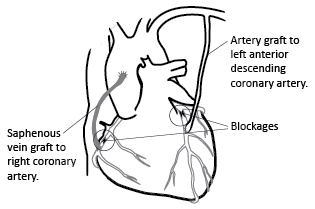The most common types of heart surgery are:
- coronary artery bypass graft (CABG or “cabbage”)
- heart valve repair or replacement
- repairing the aorta
- repairing a heart defect
In this health topic, we will talk about CABG and valve surgery.
Coronary Artery Bypass Surgery (CABG)
When a coronary artery becomes narrow or blocked, less blood can get to the heart muscle. This means that part of the heart muscle isn’t getting enough oxygen. This may cause:

- angina (the heavy, tight, squeezing, aching, pressure, or burning feeling in the chest, throat, jaw, arms, or between shoulder blades)
- shortness of breath
- a heart attack
CABG surgery uses small arteries or veins from other parts of the body and grafts them to create a bypass for the blood flow around the narrowed or blocked areas.
- Artery grafts are usually taken from behind the breastbone or from the wrist.
- Vein grafts are usually taken from the leg.

Heart Valve Surgery
Valves may be damaged by:
- rheumatic fever or other infections
- aging
- a birth defect
- failure of the heart muscle
Healthy valves open all the way to let the blood flow through. They then close all the way so that the blood doesn’t flow backwards.
Over time, damaged valves become scarred and narrow. The narrowing is called stenosis.

When the valves are damaged, they don’t open or close fully. Since one of the things valves do is stop blood from flowing backwards (called regurgitation), a valve that’s damaged may cause 2 things to happen:
- your heart has less blood to pump
- your heart has to work harder because blood flowed back into the heart chambers, the pressure inside the chambers of the heart go up
Some damaged heart valves can be repaired, while others have to be replaced.
Replacement valves can be mechanical or tissue.
- Mechanical valves are man-made valves. While they tend to last a long time, you’ll have to take a blood thinner (anticoagulant) every day and have regular blood tests for the rest of your life.
- Tissue valves are made from human or animal tissue. While they tend not to last as long as a mechanical valve, you may not have to take a blood thinner or only take one for a short time.
Your heart surgeon will talk to you about what the best choice is for you.
Some valve procedures are done with a minimally invasive approach. This means that you’ll have several very small incisions instead of one big one down the centre of your chest. The surgical incision could be in different locations like the side or front of your chest. Recovery times will vary with different procedures. Your surgeon will talk to you about the option that is best for you.
